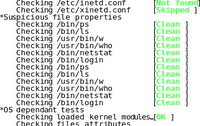Today is the dawn of a new year, the year 2007. Every year, we wish, hope and dream that it will be the year when GNU/Linux will gain critical mass appeal - not that it has failed to significantly widen its base. One of the most endearing aspect of GNU/Linux for me over and above the ideological considerations is its simplicity.
A couple of years back, when I was yet to be introduced to Linux, I remember having faced many situations when my OS (Windows 98) had died on me for no apparent reason and I was left staring at the blue screen of death. The outcome being doing a clean re-install of Windows. From those experiences, I realized that the Windows was a complex beast especially when it came to troubleshooting problems. Compared to that, troubleshooting in GNU/Linux is akin to a piece of cake or a walk in the park.
The inherent strength of GNU/Linux lies in the fact that all the configuration pertaining to the OS is saved in liberally commented text files which reside in a specific location. And almost all actions executed by the OS is logged in the appropriate files which are also plain text files. For example, reading the file /var/log/messages will reveal a wealth of knowledge about the actions carried out by the OS and the errors if any during boot-up. So once the initial learning curve is overcome, it becomes a joy to work in GNU/Linux.
The inherent strength of GNU/Linux lies in the fact that all the configuration pertaining to the OS is saved in liberally commented text files which reside in a specific location. And almost all actions executed by the OS is logged in the appropriate files which are also plain text files. For example, reading the file /var/log/messages will reveal a wealth of knowledge about the actions carried out by the OS and the errors if any during boot-up. So once the initial learning curve is overcome, it becomes a joy to work in GNU/Linux.

Some time in 2007, we can hope to see KDE 4.0 released. Already, when I compare KDE 3.5 with older versions, I have found significant increase in speed with which applications start up. KDE 4.0 is expected to be much more snappy as it is developed using Qt 4.0 library and will contain a lot of additional features. Of course, this year Microsoft is also officially releasing its new OS Vista. But many reviews indicate that there are lots of shortcomings in Microsoft's latest offering and the general opinion is that it is not worth its price tag.
I am not trying to disparage Microsoft but when you have a fabulous choice in GNU/Linux which comes with an unbeatable price tag (Free) and if you are able to do almost all your tasks in GNU/Linux baring say playing some of your favorite games, why would you consider buying another OS paying hundreds of dollars ? More over if you are an avid gaming enthusiast, you should rather be buying a Sony PlayStation or a Nintendo Wii or even an XBox and not an OS.
There was a time when I used to boot into Windows to carry out certain tasks. But for the past many months, I have realized that I am able to do all my tasks from within GNU/Linux itself and it has been some time now since I have booted into Windows.
I am not trying to disparage Microsoft but when you have a fabulous choice in GNU/Linux which comes with an unbeatable price tag (Free) and if you are able to do almost all your tasks in GNU/Linux baring say playing some of your favorite games, why would you consider buying another OS paying hundreds of dollars ? More over if you are an avid gaming enthusiast, you should rather be buying a Sony PlayStation or a Nintendo Wii or even an XBox and not an OS.
There was a time when I used to boot into Windows to carry out certain tasks. But for the past many months, I have realized that I am able to do all my tasks from within GNU/Linux itself and it has been some time now since I have booted into Windows.
But when we look back, Linux or rather GNU/Linux the OS has done quite well in 2006. With many popular distributions opting for a 6 Month release schedule, we get to try out at least two versions each of many distributions each year. More over, we get the latest software too. Other than that, in 2006 we also saw the open source release of Java code by Sun Microsystems - a great victory for Free software enthusiasts. The Linux BIOS project also got its share of publicity with many hardware manufacturers evincing interest in the project. So in many ways I look forward to an exciting year 2007 for GNU/Linux, Open Source and Free Software. And as always (lets hope) 2007 is going to be the Year of GNU/Linux.
On this positive note, I wish you all a very happy and prosperous New Year.
On this positive note, I wish you all a very happy and prosperous New Year.





